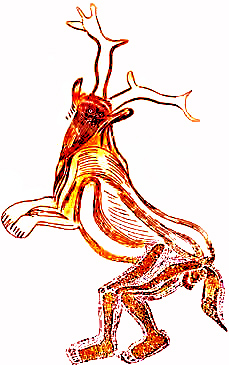The Shaman of Trois Freres
Home » Articles and News » The Shaman of Trois Freres
 Why are we so fascinated by cave paintings? I believe they are one of the most direct ways of touching our ancestors. Cave paintings document a transitional moment in human evolution when we began using symbols and images to represent our experiences and record cultural knowledge and activities.
Among the most famous of the art found in the painted Paleolithic caves of France is the Shaman of Trois Freres (pictured at left). With its bearded face of an old man and various animal parts, it dances across the cave wall, and across time, revealing the costume, activities and said to be the first representation of a shaman.
Cave art also reflects methods shamans use to achieve altered states of consciousness, the experiences of trance with visions, geometric shapes, and spirit animals and beings. It makes sense that these images depicted on cave walls are the perfect setting for a journey to the spirit world.
I am thankful the Cuyamungue Method gives us access to share that experience with the ancient ancestors. Art and Spirit is CI’s new forum to celebrate and continue this deep and long-standing intersection of art and our spiritual practices.
History and background
(1) The cave was discovered in 1914, and most of the pictures of animals, together with a couple of therianthropes (half-human, half-animal figures), are located on the walls of a deep interior chamber known as the Sanctuary. This area is filled with some 280 often-overlapping engraved figures of bison, horses, stags, reindeer, ibex, and mammoths. The great majority probably date to the mid-Magdalenian Period (about 14,000 years ago). The Sanctuary is dominated by the cave’s most famous figure, a small image, both painted and engraved, known as the Horned God, or the Sorcerer. It depicts a human with the features of several different animals, and it dominates the mass of animal figures from a height of 13 feet (4 metres) above the cave floor. Its significance is unknown, but it is usually interpreted as some kind of great spirit or master of the animals. The unusual nature of the Sanctuary’s decoration may reflect the practice of magical ceremonies in the chamber.
In a different part of the cave, there is a small chamber, known as the Chapel of the Lioness, that contains a large engraving of a lioness on a natural “altar,” with numerous special objects (animal teeth, shells, flint tools) carefully placed in crevices below it and around the walls. These are most plausibly seen as votive objects.
References:
(1) From Encyclopedia Britannica
Why are we so fascinated by cave paintings? I believe they are one of the most direct ways of touching our ancestors. Cave paintings document a transitional moment in human evolution when we began using symbols and images to represent our experiences and record cultural knowledge and activities.
Among the most famous of the art found in the painted Paleolithic caves of France is the Shaman of Trois Freres (pictured at left). With its bearded face of an old man and various animal parts, it dances across the cave wall, and across time, revealing the costume, activities and said to be the first representation of a shaman.
Cave art also reflects methods shamans use to achieve altered states of consciousness, the experiences of trance with visions, geometric shapes, and spirit animals and beings. It makes sense that these images depicted on cave walls are the perfect setting for a journey to the spirit world.
I am thankful the Cuyamungue Method gives us access to share that experience with the ancient ancestors. Art and Spirit is CI’s new forum to celebrate and continue this deep and long-standing intersection of art and our spiritual practices.
History and background
(1) The cave was discovered in 1914, and most of the pictures of animals, together with a couple of therianthropes (half-human, half-animal figures), are located on the walls of a deep interior chamber known as the Sanctuary. This area is filled with some 280 often-overlapping engraved figures of bison, horses, stags, reindeer, ibex, and mammoths. The great majority probably date to the mid-Magdalenian Period (about 14,000 years ago). The Sanctuary is dominated by the cave’s most famous figure, a small image, both painted and engraved, known as the Horned God, or the Sorcerer. It depicts a human with the features of several different animals, and it dominates the mass of animal figures from a height of 13 feet (4 metres) above the cave floor. Its significance is unknown, but it is usually interpreted as some kind of great spirit or master of the animals. The unusual nature of the Sanctuary’s decoration may reflect the practice of magical ceremonies in the chamber.
In a different part of the cave, there is a small chamber, known as the Chapel of the Lioness, that contains a large engraving of a lioness on a natural “altar,” with numerous special objects (animal teeth, shells, flint tools) carefully placed in crevices below it and around the walls. These are most plausibly seen as votive objects.
References:
(1) From Encyclopedia Britannica Home » Articles and News » The Shaman of Trois Freres
